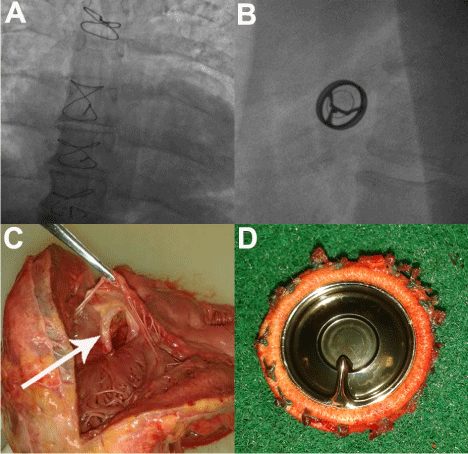Clinical Image
Late Spontaneous Dehiscence and Embolism of Mechanical Aortic Valve
Kasra Shaikhrezai1 *, Karim Morcos1, Keith Oldroyd2 and Vivek Pathi1
1Department of Cardiothoracic Surgery, Golden Jubilee National Hospital, UK
2Department of Cardiology, Golden Jubilee National Hospital, UK
*Corresponding author: Kasra Shaikhrezai, Department of Cardiac Surgery, Golden Jubilee National Hospital, Agamemnon Street, Clydebank, Greater Glasgow, G814DY, UK
Published: 29 Dec, 2016
Cite this article as: Shaikhrezai K, Morcos K, Oldroyd K,
Pathi V. Late Spontaneous Dehiscence
and Embolism of Mechanical Aortic
Valve. Clin Surg. 2016; 1: 1273.
Keywords
Aortic valve replacement; Aortic valve regurgitation; Prosthetic valve dehiscence
Clinical Image
A 52-year-old male presented with chest tightness, sudden collapse and pulmonary oedema 25 years following mechanical aortic valve replacement. Patient was previously well. Echocardiography demonstrated torrential aortic regurgitation and failed to visualize the valve. Patient arrested and urgently underwent left-heart catheterization while on automated cardiopulmonary resuscitation machine. Fluoroscopy confirmed that the valve was in the descending aorta (Figure 1A, 1B and supplementary Video 1). Patient died and post-mortem did not show any evidence of aortic dissection, aortitis or valve endocarditis (Figure 1C, 1D).
Vedio 1
Figure 2
Figure 2
A) Mechanical valve is absent in chest fluoroscopy. B) Valve is lodged at L1 level in descending aorta.
C) Post-mortem confirmed no evidence of endocarditis with healthy annulus (arrow). D) Dehisced valve with all
non-pledgeted sutures intact and tied on the sewing cuff.: Fluoroscopy showed the valve in descending aorta.


